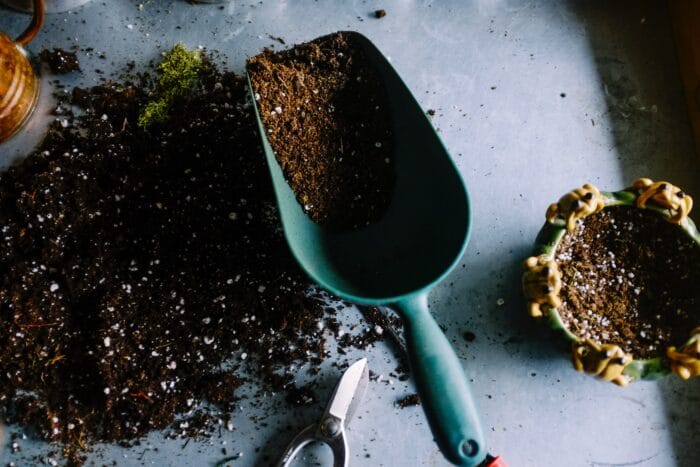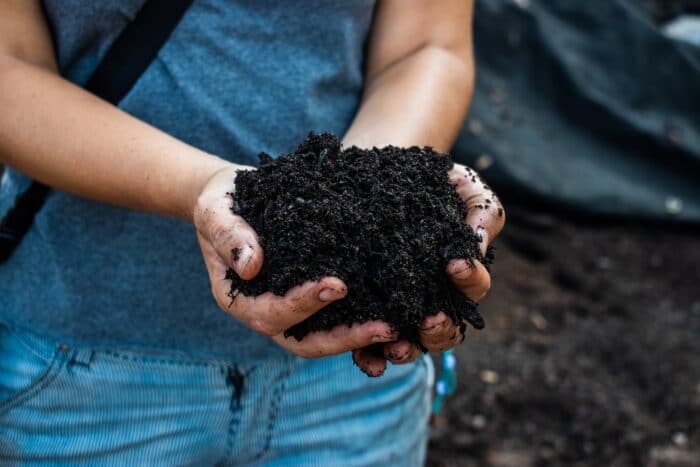As the well-known phrase goes, “gardening adds years to your life, and life to your years”. So, if you’re looking to rejuvenate your outdoor space, soil is a natural place to begin. No matter what you have planned, soil will almost certainly be the base layer of your garden or landscaping project. But more than this, it will also be the key component that will affect the performance, longevity, and even the vibrancy of your plants, grass, and everything else that you’ll be growing in your garden.
However, it’s not quite as simple as slinging some mud. For healthy, stable soil you’ll need to consider the use of both compost and topsoil for optimised results. What these consist of, and how and where to use them both, is something we cover in this guide to the difference between topsoil and compost. So here it is, topsoil vs compost, the showdown!
What is Topsoil
Top of our list in this topsoil vs compost guide is topsoil! Topsoil is the upper most layer of earth above the bedrock. Topsoil consists of a mixture of local dirt, deposited organic matter like leaves, and more often than not, small rocks, pebbles, and natural debris like wood. Because of this, it’s also the most nutrient-rich type of naturally occurring soil. Although topsoil is packed with organic matter, it’s still unlikely to be enough to get the best out of your plants. For your prized petunias (or anything for that matter), to reach their full potential, you’ll need to add compost.
What is Compost
Compost is a mixture of natural ingredients that have been deliberately combined, so, as they decompose, they break down into rich, organic matter. The nutrients released by this process are high in nitrogen, making it an ideal fertiliser. Compost can be used to improve soil structure, by opening it up and making it less compact. By creating pockets of air, you get both improved water retention and better drainage, delivering the best of both worlds. It’s no wonder compost enables plants to thrive.
Typically, the more compost you add to your topsoil, the better it will be for growing all manner of plants, flowers, vegetables and much more. Of course, like most things in life, there are limits! The best type of compost is considered to be “humus” – which is organic matter broken down to its smallest particles. It contains matter that has completely decomposed. These two factors enable it to release large quantities of micronutrients into any soil it is added to.
When to Use Topsoil
When it comes to how to use topsoil, the clue is definitely in the name. Its main use is to build up soil height to a desired level. Bulk topsoil is most often sourced from building sites, as well as agricultural fields, and even quarries as a surplus material. For this reason, topsoil often contains clay or sand, depending on where it’s come from. It’s also not uncommon for topsoil to have nutrients added to it, or even some compost, as on its own, topsoil isn’t especially fertile. But whereas the compost and nutrients will decompose over time, any clay or sand is there to stay, which is something to be mindful of. Another added extra that will almost certainly come with your topsoil are weed seeds. Unlike compost, topsoil isn’t heat treated, so these tiny soil hitchhikers aren’t removed. It’s just something you’ll need to keep in mind and prepare for when buying topsoil.
Topsoil is therefore your material of choice for building up and levelling off ground. So, if you’re raising a bed, filling in a hole, or preparing an area to lay lawn, these are prime examples of where and when to use topsoil. But in most cases, topsoil alone won’t cut it, and you’ll likely need to add compost to create garden soil that offers really first-rate growing conditions. Remember, when it comes to topsoil vs compost, it’s usually not a case of choosing one or the other – it’s using both to optimise results.
When to Use Compost
Compost will help you improve the quality of your soil. It can’t do the hard labour and construction work of topsoil – so don’t use it to change the grade of uneven ground or for real structural work. But, when it comes to making your til more nutritious and fertile, it’s a perfect choice!
With a much higher nutrient content than normal topsoil, compost has the right constituents to enable plants and flowers to grow in an optimised environment. What’s more, the nutrients contained within compost are released slowly, encouraging stable growth, and protecting the soil’s vitality for longer. And despite compost not technically being a construction material, it does improve the construction of your soil! By adding compost, you’ll improve your soil’s drainage and water holding abilities at the same time. This is especially the case for compacted and hardened soils, where compost acts as a natural loosening aid.
Compost is even good for soil health. Because of its microbial content, it can naturally boost your soil’s immunity to disease and rot. Almost all compost boasts a neutral pH of around 7 too, so it can be added to any soil type without increasing acidity on alkalinity, or potentially impacting pH sensitive plants. However, there are specialist ericaceous composts available too, designed to specifically aid plants that love acidic soils.
In short, whenever you are planting shrubs, sewing new seeds, adding flower beds, or laying lawn, you should be adding compost to your soil. For best results, rake or “till” the compost into the soil for an even distribution and nutrient release.
For above ground gardening, such as when using containers or raised beds, you can even consider planting directly into compost, especially the humus, or “type 3” stuff. This is ideal for containers, as it will ensure your soil is free of weed seeds and other contaminants.
Sourcing Top-quality Topsoil and Compost

Without industry specific guidelines or standards on how topsoil is produced, it’s important to source if from a reputable supplier. Here at Corker Outdoors, we specialise in working with homegrown brands that put people and planet first. Where we can, we also focus on bringing local products to local people. You can find our full range of topsoil and composts here and here respectively.
We hope our breakdown of topsoil vs compost, and the differences between compost and topsoil was useful. If you’re not sure what, or which, is right for your project, speak to a member of the team and they’ll be able to give you expert, impartial advice on what suits your needs best.
FAQS
Q: What is the main difference between topsoil and compost?
A: Corker topsoil is a blend of finely screened topsoil, sand and compost. Rich in nutrients and organic matter. It’s ideal for building up ground level, laying under turf, creating beds and improving the quality of existing soil. Compost, on the other hand, is a mixture of decomposed organic materials that enriches soil, improving its structure and nutrient content.
Q: Can topsoil be used on its own for planting?
A: Yes, Corker premium topsoil can be used on its own, because it’s a carefully balanced blend of finely screened topsoil, sand and compost. However, we would not recommend the Topsoil for seeds as the soil is screened to 10mm and includes small stones to promote drainage.
Q: Is compost suitable for all types of plants?
Yes, Corker’s Green compost is generally suitable for all plant types. It enriches the soil, making it more fertile and conducive to plant growth. However, there are specific compost types, like ericaceous compost for plants preferring acidic soil, and conversely Mushroom compost for neutralising acidic soil.
Q: How often should compost be added to the garden?
A: Compost should be added to the garden at least once a year. During the planting season it’s best to mix it into the soil to distribute nutrients evenly. Throughout the year keeping beds covered with a nice layer of compost can help aid moisture retention while keeping the soil healthy.
Q: Is there anything I should know when choosing or using compost?
A: Corker’s green recycled compost is an excellent all-round organic peat free compost. For a mixed bed, this product is ideal; it will enrich the soil, help to retain moisture and promote healthy plants! If you have acidic soil and wish to neutralise it, then mushroom compost is just what you need – but don’t use it if you have ericaceous (acid loving) plants such as Azaleas, Rhododendrons and Camelias. You can collect or have it delivered loose or in Bulk Bags, or for a small project we can bag it up in 25L sacks! If you aren’t sure then call our friendly sales team who can help you to choose the best compost for your project.
Q: What are the environmental benefits of using compost?
A: Compost enhances soil health, reduces the need for chemical fertilisers, and helps in recycling organic waste. It also improves water retention in soil, reducing water usage.



